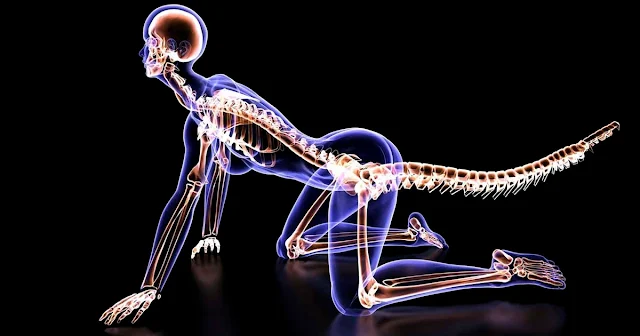One of the most remarkable changes in human evolution is the loss of our tails, a transformation that occurred around 25 million years ago. This pivotal shift not only altered the trajectory of our species but also marked a significant moment in the evolutionary history of primates. While scientists have long speculated on why humans lost their tails, the genetic cause has remained elusive—until now. A recent study published in Nature has finally uncovered the genetic factors responsible for this evolutionary change.

The Quest to Understand Tail Loss
The journey to unravel the mystery of human tail loss began in an unexpected way. Bo Xia, a graduate student at New York University, was inspired to investigate the origins of the human tailbone after injuring his own coccyx. This personal curiosity led Xia and his team to embark on a groundbreaking scientific investigation.
Through careful research, the team focused on the TBXT gene, which plays a crucial role in regulating tail length in various species. Their research revealed a unique genetic mutation within this gene, providing a major breakthrough in understanding human evolution.
The Role of Jumping Genes
A key aspect of this discovery lies in the role of Alu elements, often called “jumping genes.” These genetic elements, specific to primates, can move within the genome and cause significant changes. The researchers found that Alu elements inserted themselves into the TBXT gene, triggering a chain reaction that led to the loss of our tails.
This insertion activated a process known as alternative splicing, where RNA molecules are cut and restructured, which ultimately led to the deletion of a crucial exon. This change altered the structure and function of the resulting protein, leading to the tail loss seen in humans.
Validation Through Mice Studies
To confirm their findings, the researchers engineered laboratory mice with the same genetic mutations found in humans and apes. These genetically altered mice lost their tails, providing compelling evidence that the identified mutation plays a crucial role in the absence of tails in humans and other primates.
However, the study also uncovered a downside to tail loss: an increased risk of neural tube defects, such as spina bifida. This finding highlights the complex balance between evolutionary benefits and potential genetic trade-offs.
The Broader Implications
This discovery has profound implications not just for understanding human evolution, but also for human anatomy and health. The loss of our tails was not a random event but a genetic adaptation with lasting consequences. It illustrates the complex relationship between genetic changes and the way they shape our physiology over time.
As we continue to study our evolutionary past, these findings remind us of the intricate process of natural selection and genetic innovation that has shaped humanity. This breakthrough also underscores the power of scientific inquiry in uncovering the mysteries of our origins, offering insight into the past that can help us understand our future.
The identification of the genetic reasons behind tail loss is a testament to the persistence of scientific exploration and the ongoing quest for knowledge about our evolutionary journey.
My Stepdaughters Despised Me as Low-Class and Worthless – Suddenly, They Changed Their Minds

When I fell in love with an older man with three adult children, I had no idea what I was getting myself into. His daughters thought I was with him for his money, but when they discovered the truth about our dynamic, they tried twisting my arm, and I wasn’t having it!
I never imagined falling in love in my forties would come with so much judgment. I’m 43, and I’ve been dating Elon, a 61-year-old widower. He works in banking, and I’m a bartender. Sadly, our relationship made his daughters assume that I was only after his money an opportunistic gold digger.

A happy bartender | Source: Midjourney
I understand how, to Amanda and Claire, on the surface, it looks like a cliché, a younger woman with an older, wealthier man. His two daughters certainly thought I was looking for financial gain, while their brother, Mark, was the only one who welcomed and accepted me warmly without knowing anything about my financial standing.
What his daughters didn’t know was that they couldn’t have been more wrong about me and their father’s situation. Elon isn’t wealthy anymore. In fact, he’s broke. Meanwhile, I have a trust fund and many thriving businesses.

A well-off bartender | Source: Midjourney
The truth is that bartending is something I do because I enjoy it, not because I need the paycheck. Elon’s financial struggles aren’t because he was careless with money. He actually sacrificed everything for his late wife during her battle with cancer.
Three times, the cancer came back, and each time Elon fought harder, pouring every resource into treatment. This wonderful man maxed out six credit cards, took out a second mortgage, and drained his retirement savings to give her every possible chance.

A stressed man | Source: Midjourney
His only goal was to make sure she lived long enough to see their daughters get married, but he failed. His wife passed away a few years before we started dating. Now, he’s left with mounting debts, while his daughters live comfortably in their own suburban bubbles.
The pair live six hours away with their fiancés, and for the past two Christmases, Elon and I made the long drive to visit them. Both times, I was met with cold shoulders and passive-aggressive remarks!

Mean-looking sisters | Source: Midjourney
Amanda and Claire would ignore me, pull their father away when he tried to include me in conversations and ensure their fiancés avoided me too. The duo constantly portrayed themselves as coming from some sort of high-class family.
Periodically, they dropped rude comments about me being “just a bartender” and having nothing. They’d say things like, “At your age, being 40, it’s sad to be just that.” Elon tried to defend me as best he could.

An upset man | Source: Midjourney
The first year of our Christmas visit, Elon called them out for their behavior. They apologized, but only to him, but excused their behavior by saying it was hard to see their dad with someone who wasn’t their mom.
Because I loved Elon and saw a future with him, I decided to be understanding. Grief can twist emotions. But the second year was even worse! The thinly veiled comments about my bartending work became more direct.

A sad woman with her eyes closed | Source: Midjourney
Amanda once laughed and said, “At your age, it’s kind of sad to be just that. Waiting for a handout from our dad.”
Claire smirked but didn’t disagree. I didn’t correct them. I didn’t tell them about my trust fund or my businesses. I didn’t see the point. I don’t like boasting, and frankly, they didn’t deserve to know.
I wanted Elon’s children to like me for who I am, not what I have or can give them or their father financially. Little did I know that a gift to their father would change the relationship between me and them forever.

A happy man in a new car | Source: Midjourney
This year, I told Elon I wasn’t going. I couldn’t put myself through that humiliation again. He looked torn, saying, “I wish you’d come. It’s Christmas.”
“I can’t, my love. They don’t respect me. Why should I keep showing up to be ignored?”
He sighed. “I don’t want to do this without you, plus you know my back’s been acting up. The drive’s hard alone in that ratched car without someone to help.”
Not wanting to come between him and his family, I insisted he go alone and decided to make things easier for him.

A concerned woman | Source: Midjourney
His car had seen better days and wasn’t as comfortable for his problematic back. My brother owns a car dealership, so I leased a luxury car for him, something safe with comfortable seats for the long drive.
When Elon mentioned the car to his daughters, they exploded! They accused him of spending “their mother’s money” on me and wasting it on a “stupid car” instead of helping with their upcoming weddings. Their entitlement was astounding!

Two angry women | Source: Midjourney
They didn’t know Elon was drowning in debt or that I had paid for the car, and he couldn’t get a word in edgewise to correct their misgivings! But that wasn’t the worst of it…
Elon’s son, Mark, lived in a different country, and because of his son’s medical issues, he’d never attended holidays at his sisters’ in recent years. His life hasn’t been easy with his young son, Ethan, struggling with serious health problems, and the medical bills were piling up.

A father with his ailing son | Source: Midjourney
Mark and his wife, Sarah, had to sell their car just to keep up with treatments. They were stuck, isolated, struggling. Hearing about it broke my heart. Elon didn’t ask me to help. He barely mentioned it. But I couldn’t shake the image of Ethan and his parents stranded without a car.
So, I bought them one. It wasn’t extravagant, just a reliable SUV to get them to doctor appointments and back. I didn’t say a word to anyone about it except Elon. I didn’t do it for recognition. But the news got out.

A happy couple with a new car | Source: Midjourney
When Amanda and Claire heard about the car, naturally, they assumed Elon had bought it. They were furious!
“Why would Dad buy them a car and not help us with our weddings?” Amanda whined.
When Elon told them the truth, that I had bought the car, they went quiet. Then, suddenly, they seemed to have a change of heart and called me on their father’s phone wanting to meet. They told me and Elon that they wanted to apologize, to “clear the air.”

An upset father talking to his daughter | Source: Midjourney
I agreed to meet them but only as a test. Elon was hopeful, but I wasn’t. When they arrived at my house, which Elon lived in with me after losing the one he shared with his late wife, at first, they seemed sincere.
Amanda smiled tightly, saying, “We’re sorry. We misjudged you.”
Claire nodded. “It was wrong of us. Thank you for helping Mark. It means a lot.”
I wanted to believe them. For a moment, I thought maybe this was progress…

A suspicious woman | Source: Midjourney
Then Amanda leaned forward, voice soft and casual.
“Oh, by the way… with our weddings coming up, it’d be AMAZING if you could help with some of the costs. Nothing huge, of course.”
Claire jumped in.
“Yeah, just a little something. You’ve already been so generous.”
And there it was! The real reason they wanted to meet!
I smiled politely. “No.”

A determined woman | Source: Midjourney
Amanda’s smile vanished. Her face turned red. “Are you serious?! After everything you did for Mark?”
Claire’s expression twisted. “You’re such a hypocrite! You act all generous, but you’re selfish!”
When Amanda slammed her glass down, causing her wine to splash across the table, Elon tried to cut in, but she cut him off! “Unbelievable!” she shrieked before storming out.
Claire leaned in, eyes narrowed. “You’ll regret this. Don’t think we’re just going to let you ruin everything.”
Then she left, slamming the door behind her!

An angry woman leaving | Source: Midjourney
Elon sat in stunned silence.
“I told you they’d react like this,” I said quietly.
He stared at the empty doorway, then at me. His shoulders sagged. “I didn’t want to believe it.”
“They’ve had every chance to treat me like family, Elon. They don’t care about me. They only care about what I or you can give them.”
He nodded slowly. For the first time, I saw relief in his eyes, like he’d been holding onto some false hope and finally let it go.

A defeated man | Source: Midjourney
Later that night, Mark called, and his father put him on loudspeaker. “Thanks again for the car, Sandra! It’s already made life so much easier!”
Elon quickly filled him in on the failed meeting with his sisters, and his reply was, “I don’t know how you deal with Amanda and Claire! You are a saint!”
I laughed. “I’m not a saint, Mark. I just know where to draw the line.”

A woman laughing while talking on the phone | Source: Midjourney
Since then, Elon’s relationship with his daughters has been distant. He’s reached out, but they keep their conversations short. I feel bad for him, but I can’t fix that. The greatest thing about what happened during that meeting was that Elon’s focus had finally shifted!
We started planning small weekend getaways, enjoying quiet nights in, and reconnecting with Mark’s family! Ethan even calls me “Auntie” now, and that melts my heart!

A happy woman with a little boy | Source: Midjourney
I decided that Amanda and Claire could think what they wanted. I know the truth, and so does Elon. That’s enough. Our relationship isn’t built on money or appearances. It’s built on trust, respect, and love. And for the first time, I feel truly at peace.

A happy woman | Source: Midjourney
While Sandra’s boyfriend’s children didn’t accept her for who she is, in the following story a man with a stepdaughter struggled with their relationship. Then one day she invited him out but acted strangely, when she finally revealed the truth behind her behavior, the pair shared the warmest hug!
This work is inspired by real events and people, but it has been fictionalized for creative purposes. Names, characters, and details have been changed to protect privacy and enhance the narrative. Any resemblance to actual persons, living or dead, or actual events is purely coincidental and not intended by the author.
The author and publisher make no claims to the accuracy of events or the portrayal of characters and are not liable for any misinterpretation. This story is provided “as is,” and any opinions expressed are those of the characters and do not reflect the views of the author or publisher.



Leave a Reply